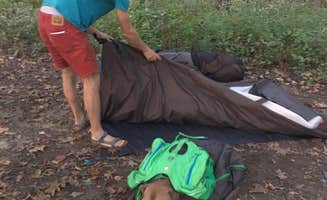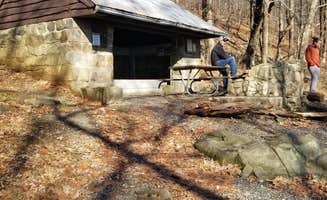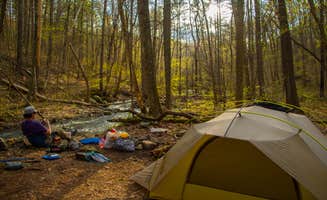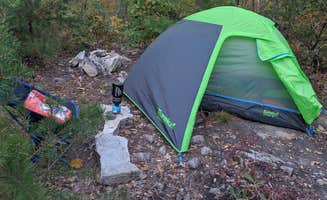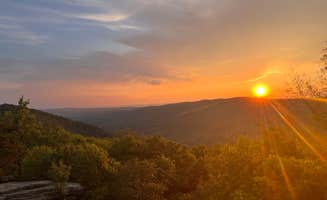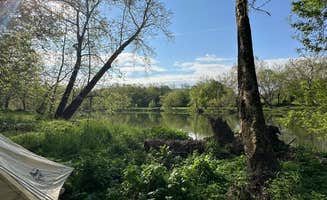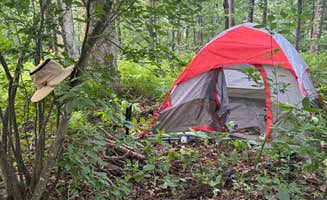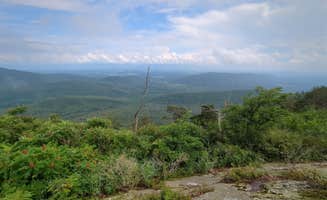Dispersed camping near Warrenton, Virginia offers primitive backcountry experiences across several national forest areas with elevations ranging from 600 to 3,500 feet. The region's mixed hardwood forests provide canopy cover throughout summer months, with temperatures varying significantly between ridge tops and valley floors. Seasonal road closures often affect access to remote sites after heavy rainfall or during winter months.
What to do
Explore riverside sites: At South Fork Shenandoah River, campers can fish and swim directly from their sites. "The site at the end of the road is beautiful. We stayed right at the end of the road, since we have a 30 foot RV, but there are sites you can walk to all the way down the river," reports one camper.
Tackle ridge hikes: The 4-mile trail to Veach Gap offers a 1,200-foot elevation gain leading to ridgeline camping. A camper notes, "Cell service at the top (not during the hike or on the road to the trailhead so prepare directions)." Bring sufficient water as sources are limited after the first mile.
Wildlife watching: Multiple dispersed sites offer opportunities to observe native wildlife. In Shenandoah National Park's backcountry, one camper reported, "There are so many trails to hike throughout the park and with a backcountry permit, you can find countless campsites." Always maintain proper food storage techniques as bear encounters are common.
What campers like
Solitude and quiet: Little Fort Campground provides established sites with amenities while maintaining a wilderness feel. "Nice flat camp site with picnic table and fire pit. Comes with tent pad but surface is too hard to use pegs. No requirements, just show up and claim your spot on the board," notes one visitor.
Accessible primitive sites: Several locations offer drive-up primitive camping within an hour of Warrenton. One camper at Wolf Gap Recreation Area described, "Most sites have a paved parking platform and then a second tier for the camp site. All sites are quite large and include picnic tables, fire rings and large tent platforms."
Seasonal variety: Fall camping brings cooler temperatures and changing foliage. One backpacker at Veach Gap shared their experience: "Went up in November with beautiful weather, fall leaves changing and great company. Couldn't have had a better experience."
What you should know
Site registration systems: Different camping areas use various methods for claiming sites. At Little Fort Campground, "You select a campsite by flipping a washer on a hook on the board from green to red. Flip it back when you leave."
Variable road conditions: Access roads to dispersed sites can be challenging. One camper at Little Fort noted, "Long and winding road to get there with no service so be cautious."
Neighbor considerations: At some riverside locations like South Fork Shenandoah River, noise can be an issue. A camper warned, "Don't disregard the warnings about noise like I did, constant speakers all the time until 4am. I think it's out of jurisdiction for park rangers so they won't do anything either."
Cell service limitations: Most dispersed camping areas have limited or no connectivity. One camper at Little Fort Campground reported, "On this app it says T-Mobile access, I'm a T-Mobile customer, no reception at all but drive 5 minutes back down the mountain and you're good to go."
Tips for camping with families
Consider established sites: For families new to dispersed camping, Shenandoah National Park offers various options. "The Shenandoah mountains and the NPS's campgrounds never get old. They always offer a unique experience offering several campgrounds giving different experiences each time. It is suitable for novice campers to experienced off-trail campers," writes one reviewer.
Scout ahead for facilities: Some dispersed sites have basic facilities while others have none. At Wolf Gap Recreation Area, "The campground has vaulted toilet and communal garbage receptical. There is a large day use area."
Plan for wildlife encounters: Teaching proper food storage is essential when camping with children in bear country. On the Laurel Prong Trail, one camper reported, "Bears were constantly checking out our tent during night... 100% do not have food scents near your tent."
Prepare for changing conditions: Weather can shift quickly in the mountains, requiring additional preparation with children. One camper at Compton Gap noted their experience was "Buggy and damp," highlighting the need for appropriate gear.
Tips from RVers
Scout access roads: Many dispersed sites have limited access for larger vehicles. At South Fork Shenandoah River, a camper with a 30-foot RV advised staying "right at the end of the road" rather than attempting to reach walk-in sites.
Level parking challenges: Finding level spots can be difficult at forest service campgrounds. One RVer at Wolf Gap observed, "Many of the car parking pads are not level. But the tent pads appear to be."
Pack extra water: No hookups means managing water carefully. When camping at sites like Crisman Hollow Road Camp, which has "many spots right on the water" but no facilities, RVers should bring sufficient water for drinking and basic needs.


